LG Wing review
Our Verdict
The LG Wing reels y'all in with intuitive software experiences that make use of the unique dual-brandish approach. Unfortunately, you lot'll pay a high toll for its middling performance, underwhelming battery life and average photograph quality.
For
- Smoothen software
- Clever dual-screen experiences for apps
- Solid swivel machinery
- Gimbal camera is useful
Against
- Very bulky
- Changing orientation tin present problems
- So-so battery life
- Poor performance for price
Tom's Guide Verdict
The LG Wing reels you in with intuitive software experiences that make use of the unique dual-display approach. Unfortunately, y'all'll pay a high price for its middling performance, underwhelming battery life and average photo quality.
Pros
- +
Polish software
- +
Clever dual-screen experiences for apps
- +
Solid hinge mechanism
- +
Gimbal camera is useful
Cons
- -
Very bulky
- -
Changing orientation can nowadays issues
- -
So-so battery life
- -
Poor performance for cost
LG Wing specs
Price: $999
Bone: Android x
Displays: six.8-inch OLED and three.9-inch secondary OLED
CPU: Snapdragon 765G
RAM: 8GB
Storage: 256GB; expandable upwards to 2TB
Rear camera: Triple-lens: 64MP broad (ƒ/1.vii), 13MP ultrawide (ƒ/1.9), 12MP ultrawide with gimbal (ƒ/two.2)
Front camera: 32MP
Battery: 4,000 mAh
Size (closed): 6.67 x two.93 10 0.43 inches
Weight: 9.74 ounces
We've already seen some of the most ambitious phones ever in the last year, and nevertheless the LG Wing withal manages to stand out.
It's a concept almost too ludicrous to exist. The LG Fly is a dual-screen phone, but yous wouldn't know it by looking at it straight away. That's because the second panel is hiding behind the master one, and is only revealed when the the big 1 on summit is swiveled out of the manner.
- All-time foldable phones
- LG Velvet vs. Samsung Galaxy S20: How LG'southward phones compare to flagships
- LG Wing vs Samsung Galaxy Z Fold two: Which dual-screen telephone wins?
Information technology's jarring in pictures, fifty-fifty more jarring in real life, and while a neat party play tricks, it's non really the most elegant approach to dual-screens we've ever laid optics on. The T-shaped upshot ultimately resembles ii candy bar handsets glued together.
But what they say about books and their covers likewise applies to the LG Wing. This phone tin deliver some clever and useful software experiences past virtue of its weird pattern and gimbal-equipped camera. Unfortunately, our LG Wing review finds that the phone's loftier price and relatively poor performance, photograph quality and battery life keep it from ascending to our listing of the all-time phones.
LG Wing: Price and availability
The LG Fly costs $999, and was initially released through Verizon. The device is at present available from AT&T and T-Mobile likewise.
In that location's only i configuration of the Wing, with 8GB of RAM and a generous 256GB of storage; yous tin also aggrandize available infinite by up to another 2TB with the use of a microSD card.
LG Wing review: Blueprint
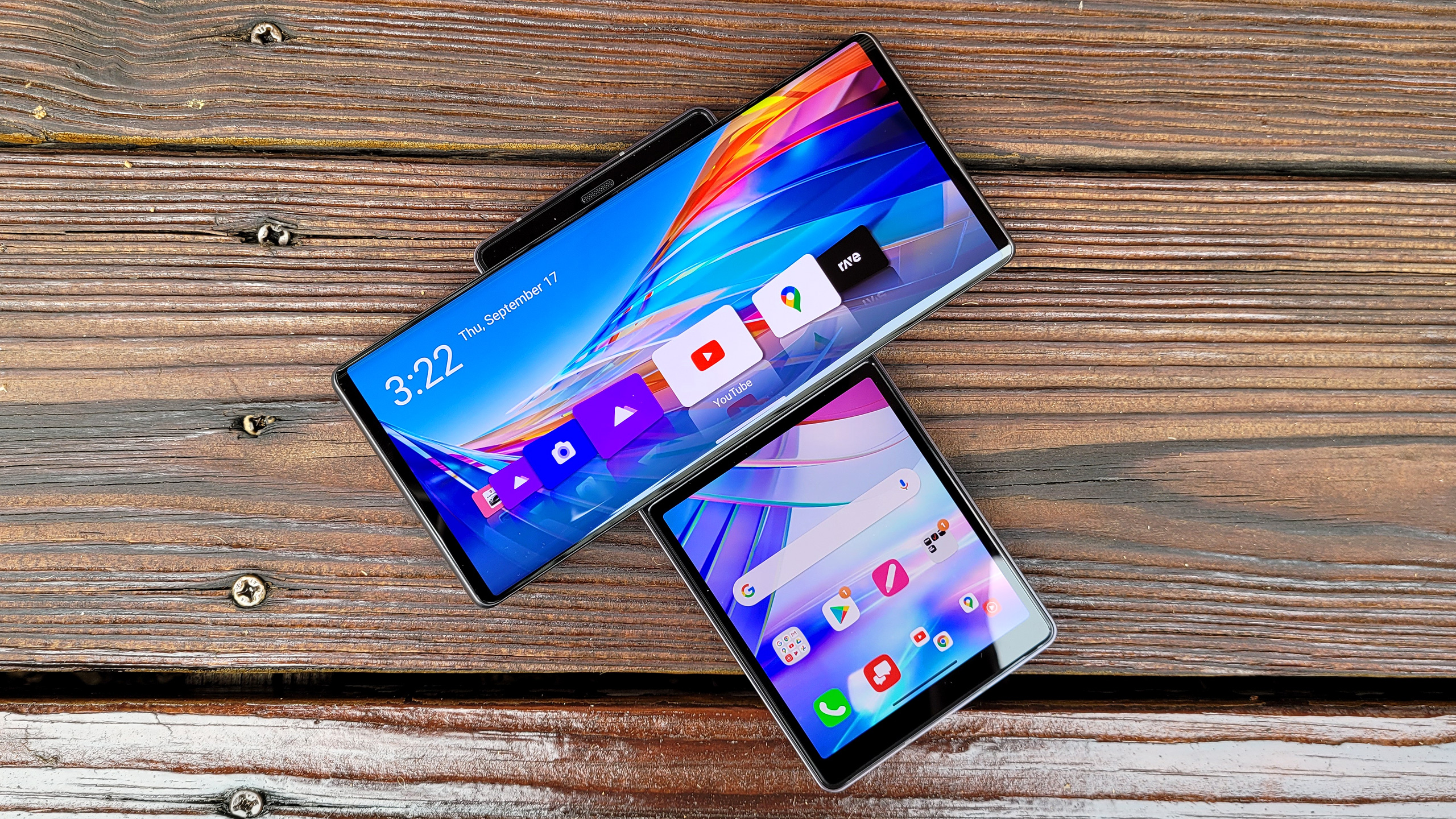
At well-nigh half dozen.vii inches tall, more than four-tenths of an inch thick and tipping the scales at a smidge nether x ounces, the LG Fly is a seriously massive telephone. Even the super-sized Samsung Milky way Note 20 Ultra is two ounces lighter and a 10th of an inch thinner. Those may audio like negligible numbers, but they make a massive divergence in hand.
I won't spend besides much time on the Wing's blueprint bated from the dual-screen aspect, just information technology's a handsome enough device, with an elegant matte aluminum frame and mirrored glass back, touched off with a triple-lens rear camera housing that almost looks lifted wholesale from Samsung'due south latest Notes.
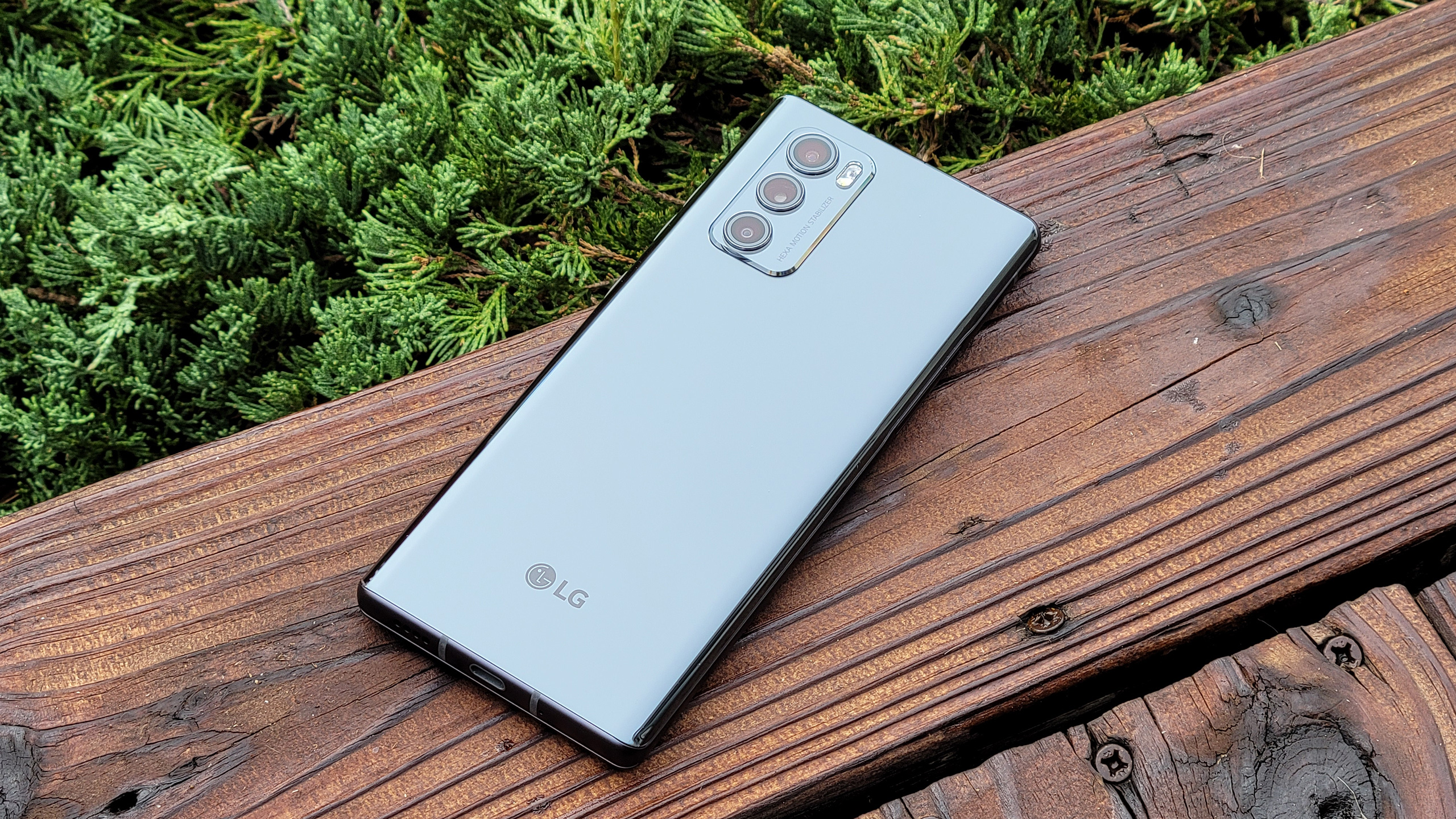
Inevitably, however, you forget about all of that the very first fourth dimension you picture the Wing'due south primary vi.8-inch OLED display over to the left, revealing a three.9-inch panel underneath. The top panel slides away with a light bear upon in i swift, smooth motion that slows downward as information technology terminates and soft closes, in tandem with a simulated click from the software. Endmost the display requires the utilize of ii hands, though opening information technology can exist done with the effortless swipe of a thumb.
LG says the Wing is built to withstand 200,000 swivels, which the company estimates should terminal you five years. The whole mechanism feels very sturdy; during the pre-production preview stage, I noticed the slightest degree of vertical flexing when I gently try to lift that top display upward and down, simply LG seems to have stamped that out in the last product and the issue is solid.
When y'all spin that superlative screen to the side, you're greeted with a dual-screen domicile interface. On the 6.8-inch console, you lot'll discover what LG calls Hinge Home, which displays large app shortcuts in a horizontal mode. On the other screen, y'all'll find your more conventional Android home screen interface. Interestingly, Android navigation bar gestures are attainable from both panels, as is the app drawer.
Two points worth stipulating: LG is 1 of the lone phone makers committed to the iii.v-millimeter headphone jack, though you unfortunately won't discover one in the Wing — in that location simply wasn't enough room, which is understandable when you consider LG had no pick but to stash the front-facing selfie camera inside a motorized pop-out mechanism. Additionally, with and then many moving parts, the Wing is not certified h2o resistant in any capacity; slightly disappointing, albeit hardly surprising.
LG Fly review: Dual-screen experience and software
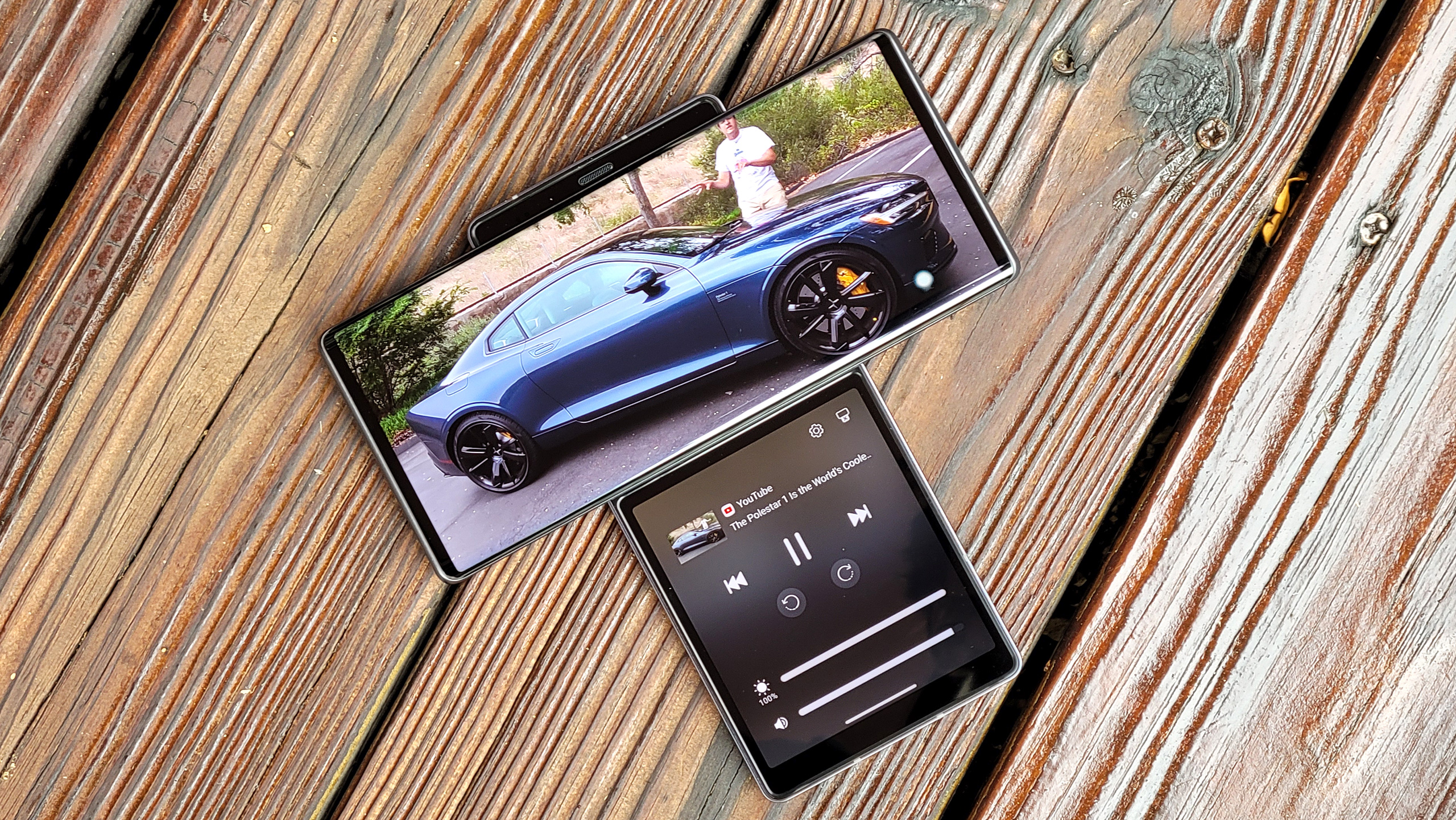
While I've encountered some circumstances where the Fly isn't sure how to orient apps on both displays depending on the gyroscope'south position, for the most role, my impressions of the Fly's user experience are positive.
Not simply does LG's software react fluidly and rapidly when new apps enter the mix or presume the foreground (looking at you, Microsoft Surface Duo), but the company has devised some pretty clever uses for the extra real manor when you're not multitasking.
For example, if yous're watching a YouTube video in portrait orientation, and then you movie the screen sideways, the video you're watching will take on a landscape crop, while the modest screen volition exist employed for playback controls and book and brightness sliders. The addition of a effulgence slider is such a simple but smart idea, because it'due south frequently something I find myself adjusting when I decide to spotter a video on my telephone. The Fly puts that right within view.
A small pop-out push button on that second screen allows yous to hide or bear witness those additional controls, making information technology like shooting fish in a barrel to then burn up a second app, similar Google Chrome, for example, and have both chugging along at once. The Wing also allows pairing of apps y'all plan on using together — like, say, if you want to have YouTube playing on the main display while y'all scan Twitter on the other panel.
Any app can run on that 2d screen, though some may have to be whitelisted in the device's settings, because they haven't been vetted by LG to evangelize a consistent experience. The lone exception to this are games; Asphalt 9, for example, volition exclusively use the second screen to display a track map, or to nowadays LG's Game Tools, which offering a quick and easy way to toggle graphics settings, take screenshots and more.
LG Wing review: Displays
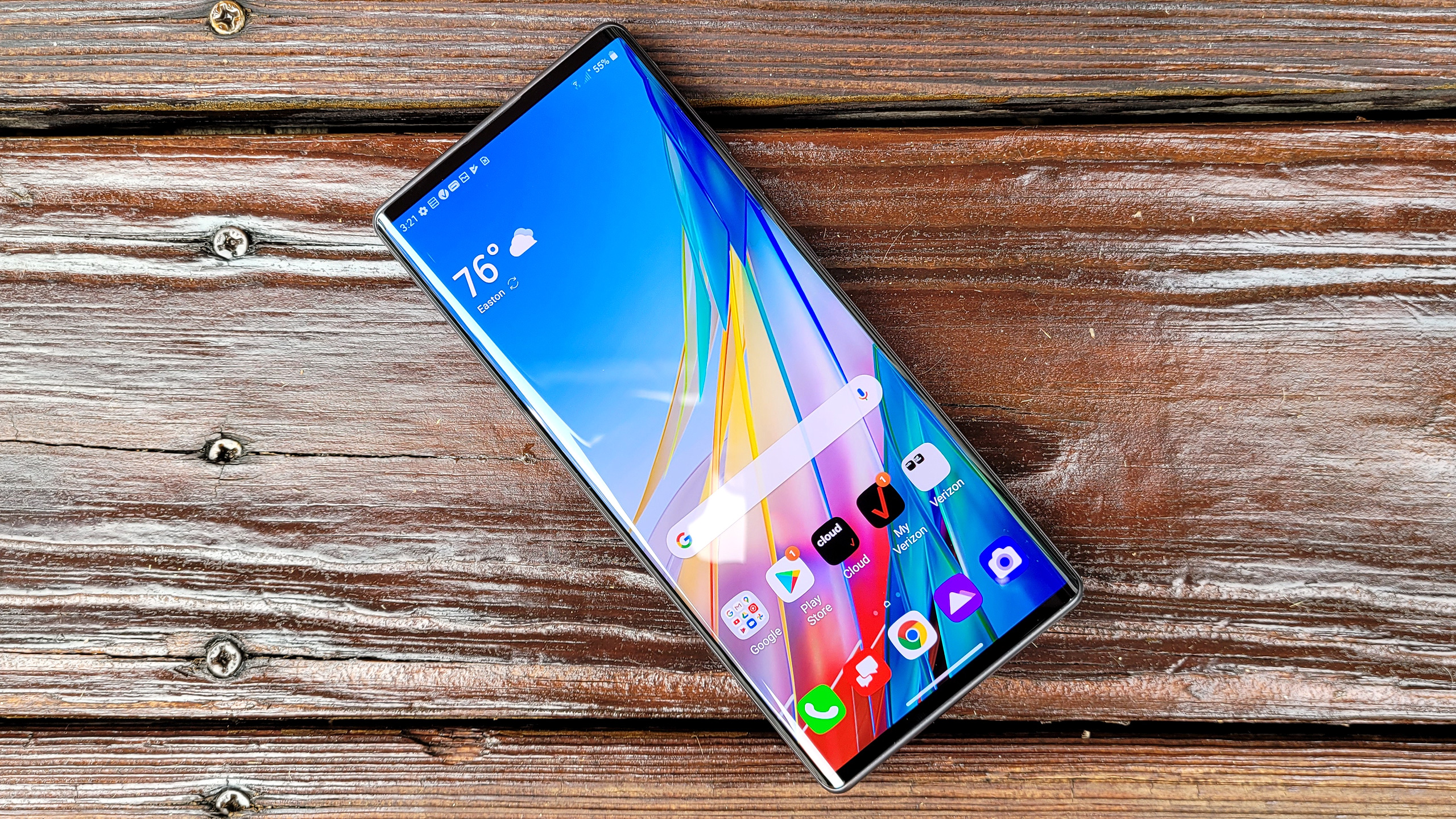
The LG Wing'southward dual-OLED display setup is certainly odd, simply the quality of these screens is high.
The telephone'southward primary 6.viii-inch console packs a resolution just northward of full Hard disk drive, and hit 643 nits in our full-screen brightness test with adaptive brightness on. That's amend than the iPhone 12's 569 nits, and bright enough to ensure comfortable outdoor viewing on either brandish — the phone increases the effulgence of both screens simultaneously when you suit the slider.
The Fly'due south main display as well covers 105% of the DCI-P3 color space in its Natural color mode, which translates into colors that popular, just don't sear your optics with over-saturation.
There are other available colour profiles for those looking for hues that really flare-up off the glass, though I was satisfied with the advent of on-screen content in Natural mode when I watched the trailer for the David Bowie biopic Stardust. In one scene, the reddish calorie-free from a concert stage bathed the oversupply and Ziggy himself in cerise light, which juxtaposed the stark black of the shadows nicely.
In that location'south not much to say virtually the Wing'due south other screen — another OLED panel taking on a more square-like aspect ratio but a similar overall resolution in the neighborhood of full Hard disk drive. Like the main screen, though, it makes do with a pedestrian 60Hz refresh rate, which is actually becoming quite dated for the cost bracket the Wing is playing in. (The Galaxy S20 phones, which range in cost from $699 to $1,399, all offer 120Hz refresh rates, for instance.)
LG Wing review: Cameras and gimbal
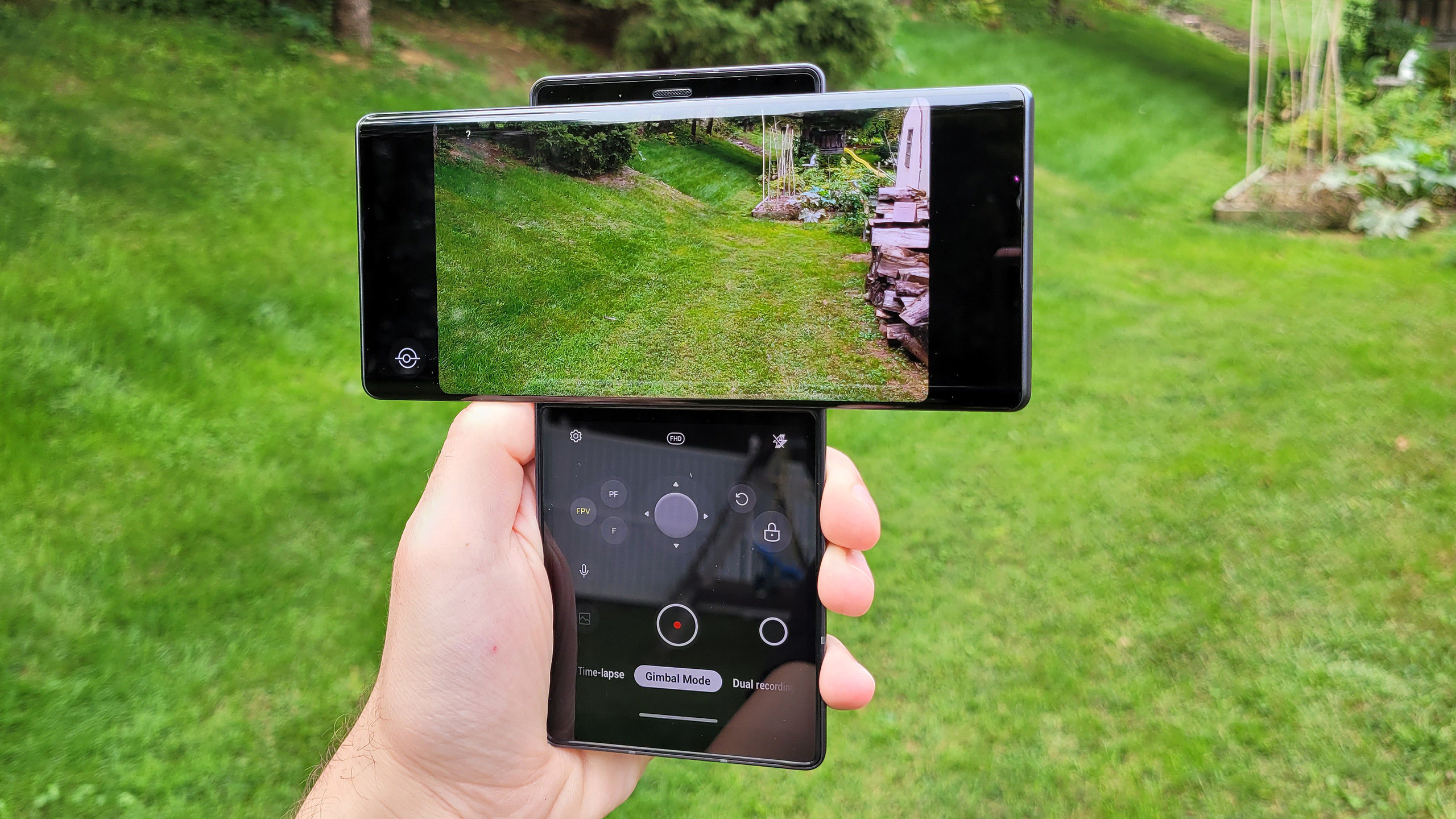
The LG Wing's other marquee feature, also its screens, pertains to its camera system. And while triple-lens shooters are hardly original by today's standards, the Wing differentiates itself from even more than loftier-end devices with a gimbal-equipped ultrawide lens that can pan automatically or manually (via an on-screen joystick) for smooth movement.
Although y'all'll find a principal 64-megapixel main camera and a 13MP ultrawide lens on the back of the Fly, it'due south the 12MP optic situated in the eye of the trio, specifically designed for video, that benefits from LG's new Hexa Motion Sensor engineering science.
Interestingly, there'southward seemingly no way to make use of the gimbal unless you lot have the master display flipped open, as all the controls for the gimbal are housed in the secondary panel. This is a practiced thought though, because it leverages the Fly's unique form factor to make it better equipped for one-paw shooting, while also giving those controls a identify to live, and so they don't clutter up the viewfinder.

At first glance, the array of gimbal shooting modes are quite vexing, though they're relatively quick to grasp in do. In that location are three modes — Pan Follow, Outset Person View, and Follow — that each carry differently in terms of orientation and object tracking.
I notice the Wing'south congenital-in gimbal exponentially easier to apply than the Zhiyun motorized gimbal I've tried to utilize in the past — especially with Pan Follow fashion, which keeps the bailiwick in the frame for as long every bit possible by moving the lens irrespective of the phone, while also stamping out vertical juddering motions stemming from shaky hands.
Follow Way fully compensates for all movements on both axes past swiveling the lens, so that the horizon always remains level, while Beginning Person View allows the horizon to tilt, and essentially produces videos well-nigh like to normal shooting. If this is hard to empathize in text — and I'm sure it is — fortunately there'due south a handy graphic in the lesser-left corner of the screen that helps keep y'all enlightened of the camera's orientation at all times.
When y'all turn to stills, though, the Wing struggles somewhat. Photos captured with the primary camera tend to lack color and detail if lighting isn't ideal, while peculiarly low-light shots exhibit lots of noise.
Compare these indoor shots of some books and trinkets on a shelf. The Wing delivers a by and large noisier shot, with white balance that is slightly off, contributing to a green cast. Information technology also fails to home in on effectively details, like the texture of the white wall in the groundwork. The Pixel 5 produced a comparatively blemish-gratis consequence.
You tin can run into information technology here, in this shot of a fake constitute, where both devices' Portrait Modes are applied. The endeavor from the Wing is far nosier and dimmer, with the solid wood surface and the plant'due south green strands simply lacking necessary warmth. The bokeh also isn't as pronounced as it is on Google'due south phone, though in fairness, the Pixel 5 did erroneously apply some blur to the foreground, where it doesn't belong.
The Wing allows y'all to combine night and ultrawide camera modes — something the iPhone 12 can besides exercise, though overall I really adopt the results from LG's phone. There is a petty too much noise, especially in the sky, simply I'one thousand impressed with how sharply the Fly renders the building'southward brick exterior and the window panes. On the other hand, Apple tree's software more accurately grasps the actual colors and overall tone of the scene.
Comparing the Fly's selfie camera confronting the iPhone 12's True Depth shooter, nosotros encounter an overexposed event totally defective necessary contrast. The color from my face and my orange beanie are drained; the sharpness of my hair and the texture in the cap's fabric, blurred.
LG Wing review: Operation
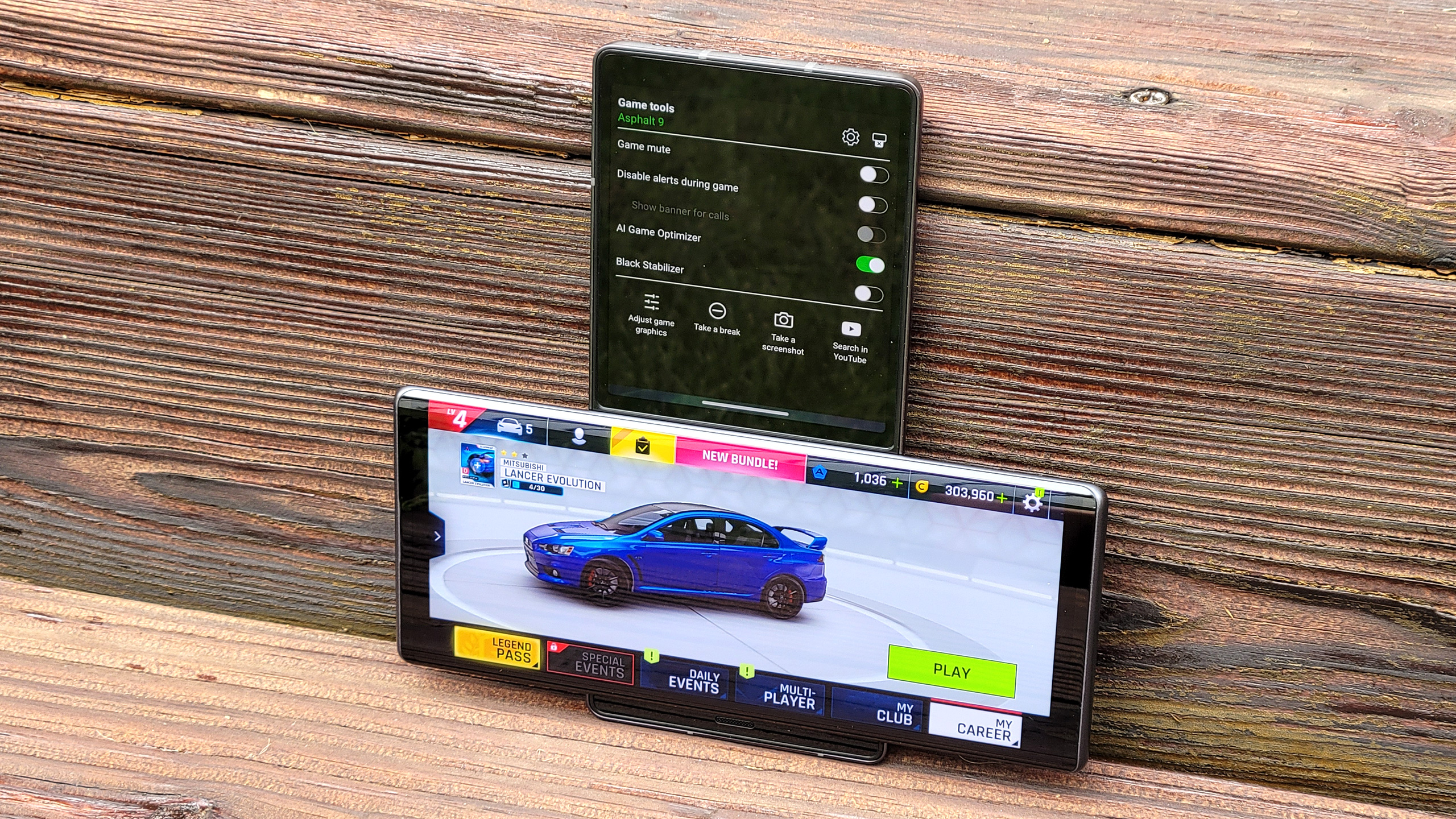
Like a growing number of 5G phones, the LG Wing is powered by a Snapdragon 765G system-on-chip. That's the same processor institute inside the LG Velvet, equally well as many other lower-price 5G-ready models, like the OnePlus Nord and the Google Pixel 4a 5G. That silicon is paired with 8GB of RAM.
Operation is mostly good, with the device acting satisfyingly quickly to switch between unmarried-screen and dual-screen modes. Despite my slight reservations entering this review, the 765G is perfectly capable of supporting two apps at one time and seems to be quite intuitive in terms of knowing what to do with them in the context of the phone's orientation and whether or not that second screen is in utilise.
Notwithstanding, this being a vii-series Snapdragon chip, graphical muscle is lacking somewhat. Asphalt 9 Legends plays at a frame rate well under 30 frames per 2nd, at a lower-than-native resolution and with jaggies and depression texture particular grow. It's not totally unresponsive and it'south not whatever worse than other handsets that employ this chip — though it is inferior to other models that cost the same, which either pack Qualcomm's faster 865 silicon or Apple'due south A14 Bionic chipset, if you're entertaining the prospect of buying iPhone.
In the organisation-broad Geekbench v benchmark, the Wing delivered a multicore score of 1,891 points. For reference, the iPhone 12 Pro, which costs exactly the aforementioned as the Wing, hit 3,880, while Samsung's Galaxy Annotation twenty topped out at 3,182. Both start at $999, just similar LG's device.
Turning to 3DMark'south Wild Life graphics benchmark, there nosotros saw a 1,643 score at 9.viii frames per 2nd. Both the iPhone 12 Pro (6,567, 39 fps) and Galaxy Note 20 Ultra (4,164, 24.9 fps) handily surpassed the Wing here too.
In fact, you can get a device well-nigh as powerful as the Wing at or less than one-half the price, if you opt for the new $399 TCL x 5G UW or $499 Google Pixel 4a 5G. Both of these handsets characteristic 765G processors and 5G connectivity, though they obviously lack 2nd screens and gimbal cameras. This is all to say that if yous're buying the Wing for its performance, yous're doing so for the wrong reasons.
LG Wing review: Battery life and charging
Backing the LG Fly's two screens is a 4,000-mAh battery, which matches the size of the power pack in Verizon's version of the LG'south other new phone, the Velvet.
As our testing of the AT&T version of the Velvet demonstrated, LG does have the capacity to produce devices that last a while on a charge. That telephone in particular lasted ten hours and 29 minutes in our custom web-surfing battery test, which is very good.
The Fly, on the other hand, has an extra display and the improver of millimeter-wave radios for 5G on Verizon'south network, which seize with teeth into power. Thus, in the very same battery exam using the Wing, nosotros only saw an boilerplate of viii hours and xi minutes with merely one screen lit; with both screens on, that dropped to an boilerplate of 7:03.
Thankfully, the Wing does at least accuse apace, striking 57 percent from empty in 30 minutes with its included charger. Information technology also supports wireless charging, which is very impressive, given everything this device has going on beneath the glass and metal.
LG Wing review: Verdict
The LG Wing may not exist the sleekest or about powerful telephone in the world, but it is certainly a unique i. It's a function-over-form device in the nearly brazen way, and it's downright cumbersome to hold at times.
Yet, the Fly really does encourage you lot to apply information technology in ways y'all commonly might not think to use your phone — a familiar trend amongst this year's most ambitious handsets, like the exciting-though-flawed Microsoft Surface Duo.
The Wing'southward problem is that it makes big sacrifices with regard to performance, image quality and longevity on a accuse in its dual-screen aspirations. The extra brandish real estate does lend itself well to multitasking, just in exchange for that, you're paying $1,000 for a device only half every bit powerful every bit its adversaries, that captures steady video but dreary stills.
Even though I doubt the Wing will cease up a booming disquisitional or commercial success, it's refreshing to see a company of LG's stature in the manufacture experiment with ideas like this (or the LG Rollable that it showed off at CES 2021 with a promise of releasing later this twelvemonth). The Wing is the get-go product borne out of the company's Explorer initiative, an in-house incubator to create mobile devices that reject the condition quo of soulless slabs.
There'south no denying LG has taken risks here; the problem is, those risks haven't entirely panned out well.
Source: https://www.tomsguide.com/reviews/lg-wing-review-hands-on
Posted by: elderhapat1994.blogspot.com


0 Response to "LG Wing review"
Post a Comment